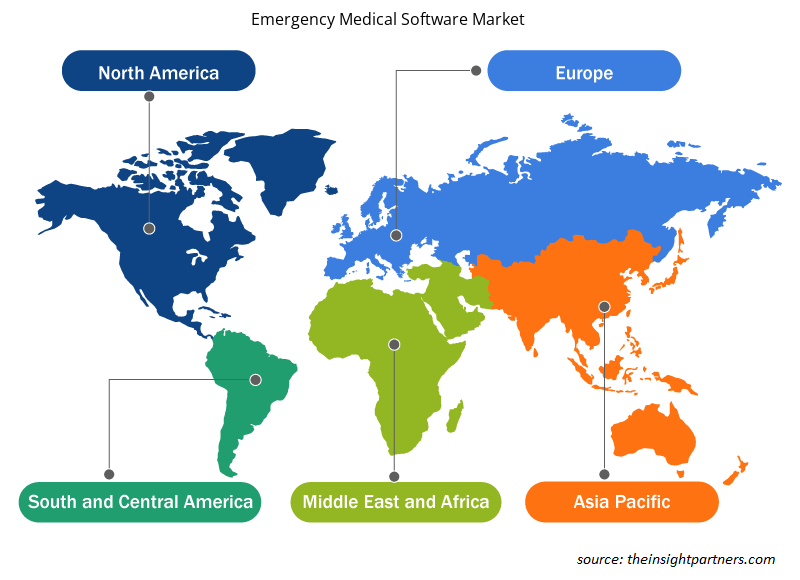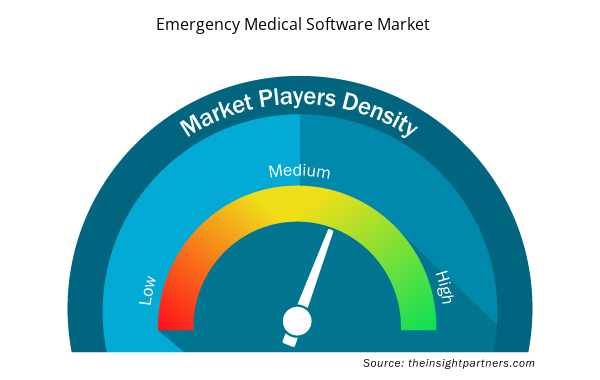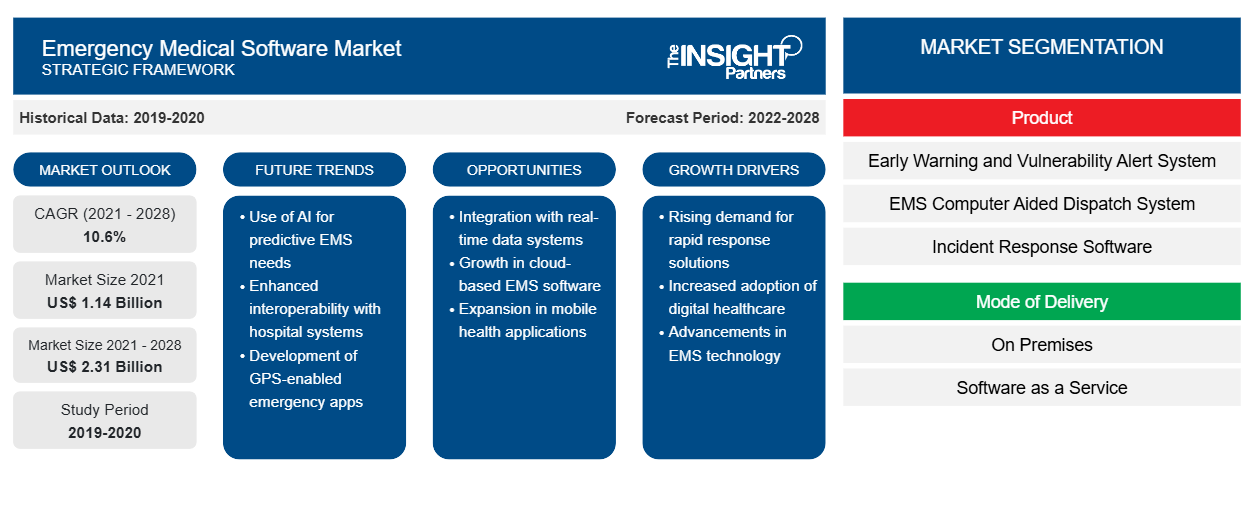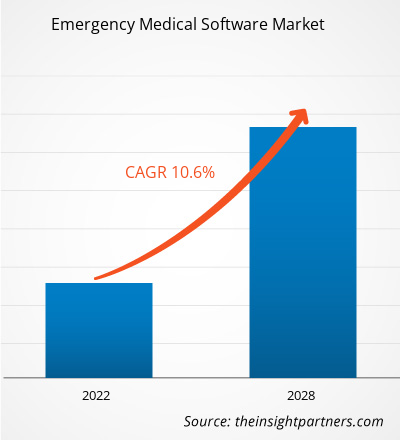Si prevede che il mercato del software per la medicina di emergenza raggiungerà i 2.313,20 milioni di dollari entro il 2028, rispetto ai 1.144,91 milioni di dollari del 2021; si stima che crescerà a un CAGR del 10,6% nel periodo 2021-2028.CAGR of 10.6% during 2021-2028.
Il software di medicina d'urgenza è utilizzato per rispondere a incidenti medici e fornire cure mediche d'urgenza. EMS si concentra sulle cure mediche d'urgenza del paziente/dei pazienti se un incidente causa una grave malattia o lesione. EMS è un sistema di risposta coordinato e cure mediche d'urgenza che coinvolge più persone e agenzie. Un sistema EMS completo consiste nel riconoscimento degli incidenti, nell'accesso al 911, nella spedizione e nella consapevolezza della prevenzione.
Il mercato del software medico di emergenza è segmentato in base a prodotto, modalità di consegna, piattaforma, utente finale e area geografica. Il mercato, per area geografica, è ampiamente segmentato in Nord America, Europa, Asia Pacifico, Medio Oriente e Africa e Sud e Centro America. Il rapporto sul mercato del software medico di emergenza offre approfondimenti e analisi approfondite del mercato, sottolineando parametri quali dimensioni del mercato del software medico di emergenza, tendenze di mercato, progressi tecnologici e dinamiche di mercato, insieme all'analisi del panorama competitivo dei principali attori del mercato a livello mondiale.
Personalizza questo report in base alle tue esigenze
Riceverai la personalizzazione gratuita di qualsiasi report, comprese parti di questo report, o analisi a livello nazionale, pacchetto dati Excel, oltre a usufruire di grandi offerte e sconti per start-up e università
- Scopri le principali tendenze di mercato in questo rapporto.Questo campione GRATUITO includerà analisi di dati che spaziano dalle tendenze di mercato alle stime e alle previsioni.
La crescita del mercato del software medico di emergenza è attribuita all'aumento dei casi di lesioni traumatiche e alla crescente spesa sanitaria. Tuttavia, la carenza di professionisti qualificati limita la crescita del mercato.
Approfondimenti di mercato
Aumento dei casi di lesioni traumatiche
Le emergenze mediche, come gli infortuni stradali, sono una delle principali cause di morte in tutto il mondo. Secondo l'Organizzazione mondiale della sanità (OMS), nel 2021 gli infortuni stradali hanno causato circa 1,3 milioni di decessi. Inoltre, più della metà di tutti i decessi dovuti a incidenti stradali riguarda pedoni, ciclisti e motociclisti. Inoltre, l'OMS ha affermato che il 93% dei decessi sulle strade nel mondo si verifica nei paesi a basso e medio reddito. Si prevede che gli infortuni stradali siano la principale causa di morte per bambini e giovani adulti di età compresa tra 5 e 29 anni. Inoltre, guidare veicoli sotto l'effetto di alcol e sostanze psicoattive o droghe aumenta il rischio di incidenti, che provocano morte o lesioni gravi. Questo è uno dei principali fattori trainanti che contribuiscono alla crescente domanda di sistemi di emergenza medica adeguati, come sistemi di risposta agli incidenti e software di gestione delle ambulanze.
Nel 2021, l'OMS ha dichiarato che le malattie non trasmissibili hanno causato 41 milioni di decessi, ovvero circa il 71% di tutti i decessi a livello globale. Inoltre, il Global Burden of Disease nel 2019 ha riportato circa 2,46 miliardi di anni di vita aggiustati per disabilità (DALY) all'anno. Questi decessi si verificano a causa di morti premature e disabilità prolungate. Inoltre, si prevede anche che, secondo una stima, oltre il 50% dei decessi e il 40% del carico totale di malattia nei paesi a basso e medio reddito potrebbero essere evitati con cure preospedaliere e di emergenza. Inoltre, i decessi totali globali affrontabili e i DALY che possono essere evitati ammontano rispettivamente a 24,3 milioni e 1.023 milioni di vite. Nell'Asia meridionale, il 90% dei decessi e l'84% dei DALY sono dovuti a condizioni di emergenza e trauma. Pertanto, l'aumento dei casi di trauma stimola la crescita del mercato del software medico di emergenza.DALYs) per year. These fatalities occur due to premature deaths and prolonged disabilities. Moreover, it is also expected that as per one estimate, more than 50% of deaths and 40% of the total burden of disease in low and middle-Income countries could be avoided with prehospital and emergency care. In addition, global total addressable deaths and DALYs that can be avoided amount to 24.3 million and 1,023 million lives, respectively. In South Asia, 90% of deaths and 84% of DALYs are due to emergency and trauma conditions. Thus, the rising cases of trauma propel the growth of the emergency medical software market.
Approfondimenti basati sui prodotti
Il mercato globale del software medico di emergenza, in base al prodotto, è segmentato in sistema di allerta precoce e vulnerabilità (EWVAS), sistema di invio assistito da computer EMS (CAD) , software di risposta agli incidenti, software di gestione delle ambulanze e altri. Il segmento del software di risposta agli incidenti ha detenuto la quota di mercato più grande nel 2021. Inoltre, si prevede che lo stesso segmento registrerà il CAGR più elevato nel mercato durante il periodo di previsione, poiché il prodotto è utilizzato più comunemente nella pratica.EWVAS), EMS CAGR in the market during the forecast period, as the product is used most commonly in practice.
Informazioni basate sulla modalità di consegna
Il mercato globale del software medico di emergenza, in base alla modalità di distribuzione, è diviso in on premise e software-as-a-service (SaaS). Il segmento on premise ha detenuto una quota di mercato maggiore nel 2021. Tuttavia, si prevede che il segmento SaaS registrerà un CAGR più elevato nel periodo 2021-2028 a causa di una maggiore distribuzione di sistemi e soluzioni SaaS basati su cloud rispetto alle soluzioni on premise.
Approfondimenti basati sulla piattaforma
Il mercato globale del software medico di emergenza, basato sulla piattaforma, è segmentato in Windows, Android, iOS e altri. Il segmento Windows ha detenuto la quota maggiore del mercato nel 2021. Inoltre, si prevede che lo stesso segmento registrerà il CAGR più elevato nel mercato durante il periodo di previsione.CAGR in the market during the forecast period.
Approfondimenti regionali sul mercato del software medico di emergenza
Le tendenze regionali e i fattori che influenzano il mercato del software medico di emergenza durante il periodo di previsione sono stati ampiamente spiegati dagli analisti di Insight Partners. Questa sezione discute anche i segmenti del mercato del software medico di emergenza e la geografia in Nord America, Europa, Asia Pacifico, Medio Oriente e Africa e Sud e Centro America.

- Ottieni i dati specifici regionali per il mercato del software medico di emergenza
Ambito del rapporto di mercato del software medico di emergenza
| Attributo del report | Dettagli |
|---|---|
| Dimensioni del mercato nel 2021 | 1,14 miliardi di dollari USA |
| Dimensioni del mercato entro il 2028 | 2,31 miliardi di dollari USA |
| CAGR globale (2021 - 2028) | 10,6% |
| Dati storici | 2019-2020 |
| Periodo di previsione | 2022-2028 |
| Segmenti coperti | Per Prodotto
|
| Regioni e Paesi coperti | America del Nord
|
| Leader di mercato e profili aziendali chiave |
|
Densità dei player del mercato del software medico di emergenza: comprendere il suo impatto sulle dinamiche aziendali
Il mercato del software medico di emergenza sta crescendo rapidamente, spinto dalla crescente domanda degli utenti finali dovuta a fattori quali l'evoluzione delle preferenze dei consumatori, i progressi tecnologici e una maggiore consapevolezza dei vantaggi del prodotto. Con l'aumento della domanda, le aziende stanno ampliando le loro offerte, innovando per soddisfare le esigenze dei consumatori e capitalizzando sulle tendenze emergenti, il che alimenta ulteriormente la crescita del mercato.
La densità degli operatori di mercato si riferisce alla distribuzione di aziende o società che operano in un particolare mercato o settore. Indica quanti concorrenti (operatori di mercato) sono presenti in un dato spazio di mercato in relazione alle sue dimensioni o al valore di mercato totale.
Le principali aziende che operano nel mercato del software per la medicina di emergenza sono:
- Software Quark
- Azienda
- Gruppo Trapezio
- Società Cerner
- Assistenza sanitaria GE
Disclaimer : le aziende elencate sopra non sono classificate secondo un ordine particolare.

- Ottieni una panoramica dei principali attori del mercato dei software di medicina di emergenza
Informazioni basate sull'utente finale
Il mercato globale del software medico di emergenza, in base all'utente finale, è suddiviso in commerciale, agenzie statali e cittadine, municipali e altri. Il segmento commerciale ha detenuto la quota maggiore nel 2021 e si stima che registrerà il CAGR più elevato nel mercato durante il periodo di previsione. Si prevede che il mercato per questo segmento assisterà a una crescita costante poiché gli spazi commerciali vengono sviluppati secondo rigidi standard e linee guida che impongono la presenza di sistemi di rilevamento precoce, software di risposta agli incidenti e altri. Inoltre, poiché gli ospedali privati fanno parte del segmento, si prevede che il mercato per il segmento commerciale vedrà una crescita costante nei prossimi anni.
I lanci e le approvazioni di prodotti sono strategie comunemente adottate dalle aziende per espandere la propria presenza globale e i portafogli di prodotti. Inoltre, gli operatori del mercato del software medico di emergenza si concentrano sulla strategia di partnership per ampliare la propria clientela, il che, a sua volta, consente loro di mantenere il proprio marchio in tutto il mondo. Si prevede che la quota di mercato prospererà con lo sviluppo di nuovi prodotti innovativi da parte degli operatori del mercato.
Profili aziendali
- Software Quark
- Azienda
- Gruppo Trapezio
- Società Cerner
- Assistenza sanitaria GE
- PIAZZA CENTRALE
- Traumasoft
- Servizi offerti da AngelTrack LLC
- Salute EMIS
- MEDHOSTA
- Ems epici
- Analisi storica (2 anni), anno base, previsione (7 anni) con CAGR
- Analisi PEST e SWOT
- Valore/volume delle dimensioni del mercato - Globale, regionale, nazionale
- Industria e panorama competitivo
- Set di dati Excel



Report Coverage
Revenue forecast, Company Analysis, Industry landscape, Growth factors, and Trends

Segment Covered
This text is related
to segments covered.

Regional Scope
North America, Europe, Asia Pacific, Middle East & Africa, South & Central America

Country Scope
This text is related
to country scope.
Domande frequenti
The emergency medical software market majorly consists of the players such as Quark Software Inc., Sun Ridge Systems, Inc., Trapeze Group, Cerner Corporation, GE Healthcare, CENTRALSQUARE, Traumasoft, AngelTrack LLC, EMIS Health, MEDHOST, Epic EMS.
Based on geography, the APAC region is accounted for highest CAGR in emergency medical software market during the forecast period.
The incident response software segment under product segment, held the largest share in 2021.
Emergency medical software are solutions that are used by hospitals, healthcare professionals, first responders, and paramedics to aid a coordinated effort towards providing emergency services to the public. The software tracks time, patient records, billing, and vehicle management, among other tasks for public and private emergency medical departments and organizations to streamline emergency medical efforts.
Trends and growth analysis reports related to Technology, Media and Telecommunications : READ MORE..
The List of Companies - Emergency Medical Software Market
- Quark Software
- Sun Ridge Systems, Inc.
- Trapeze Group
- Cerner Corporation
- GE Healthcare
- CENTRALSQUARE
- Traumasoft
- AngelTrack LLC
- EMIS Health
- MEDHOST
- Epic EMS
The Insight Partners performs research in 4 major stages: Data Collection & Secondary Research, Primary Research, Data Analysis and Data Triangulation & Final Review.
- Data Collection and Secondary Research:
As a market research and consulting firm operating from a decade, we have published and advised several client across the globe. First step for any study will start with an assessment of currently available data and insights from existing reports. Further, historical and current market information is collected from Investor Presentations, Annual Reports, SEC Filings, etc., and other information related to company’s performance and market positioning are gathered from Paid Databases (Factiva, Hoovers, and Reuters) and various other publications available in public domain.
Several associations trade associates, technical forums, institutes, societies and organization are accessed to gain technical as well as market related insights through their publications such as research papers, blogs and press releases related to the studies are referred to get cues about the market. Further, white papers, journals, magazines, and other news articles published in last 3 years are scrutinized and analyzed to understand the current market trends.
- Primary Research:
The primarily interview analysis comprise of data obtained from industry participants interview and answers to survey questions gathered by in-house primary team.
For primary research, interviews are conducted with industry experts/CEOs/Marketing Managers/VPs/Subject Matter Experts from both demand and supply side to get a 360-degree view of the market. The primary team conducts several interviews based on the complexity of the markets to understand the various market trends and dynamics which makes research more credible and precise.
A typical research interview fulfils the following functions:
- Provides first-hand information on the market size, market trends, growth trends, competitive landscape, and outlook
- Validates and strengthens in-house secondary research findings
- Develops the analysis team’s expertise and market understanding
Primary research involves email interactions and telephone interviews for each market, category, segment, and sub-segment across geographies. The participants who typically take part in such a process include, but are not limited to:
- Industry participants: VPs, business development managers, market intelligence managers and national sales managers
- Outside experts: Valuation experts, research analysts and key opinion leaders specializing in the electronics and semiconductor industry.
Below is the breakup of our primary respondents by company, designation, and region:

Once we receive the confirmation from primary research sources or primary respondents, we finalize the base year market estimation and forecast the data as per the macroeconomic and microeconomic factors assessed during data collection.
- Data Analysis:
Once data is validated through both secondary as well as primary respondents, we finalize the market estimations by hypothesis formulation and factor analysis at regional and country level.
- Macro-Economic Factor Analysis:
We analyse macroeconomic indicators such the gross domestic product (GDP), increase in the demand for goods and services across industries, technological advancement, regional economic growth, governmental policies, the influence of COVID-19, PEST analysis, and other aspects. This analysis aids in setting benchmarks for various nations/regions and approximating market splits. Additionally, the general trend of the aforementioned components aid in determining the market's development possibilities.
- Country Level Data:
Various factors that are especially aligned to the country are taken into account to determine the market size for a certain area and country, including the presence of vendors, such as headquarters and offices, the country's GDP, demand patterns, and industry growth. To comprehend the market dynamics for the nation, a number of growth variables, inhibitors, application areas, and current market trends are researched. The aforementioned elements aid in determining the country's overall market's growth potential.
- Company Profile:
The “Table of Contents” is formulated by listing and analyzing more than 25 - 30 companies operating in the market ecosystem across geographies. However, we profile only 10 companies as a standard practice in our syndicate reports. These 10 companies comprise leading, emerging, and regional players. Nonetheless, our analysis is not restricted to the 10 listed companies, we also analyze other companies present in the market to develop a holistic view and understand the prevailing trends. The “Company Profiles” section in the report covers key facts, business description, products & services, financial information, SWOT analysis, and key developments. The financial information presented is extracted from the annual reports and official documents of the publicly listed companies. Upon collecting the information for the sections of respective companies, we verify them via various primary sources and then compile the data in respective company profiles. The company level information helps us in deriving the base number as well as in forecasting the market size.
- Developing Base Number:
Aggregation of sales statistics (2020-2022) and macro-economic factor, and other secondary and primary research insights are utilized to arrive at base number and related market shares for 2022. The data gaps are identified in this step and relevant market data is analyzed, collected from paid primary interviews or databases. On finalizing the base year market size, forecasts are developed on the basis of macro-economic, industry and market growth factors and company level analysis.
- Data Triangulation and Final Review:
The market findings and base year market size calculations are validated from supply as well as demand side. Demand side validations are based on macro-economic factor analysis and benchmarks for respective regions and countries. In case of supply side validations, revenues of major companies are estimated (in case not available) based on industry benchmark, approximate number of employees, product portfolio, and primary interviews revenues are gathered. Further revenue from target product/service segment is assessed to avoid overshooting of market statistics. In case of heavy deviations between supply and demand side values, all thes steps are repeated to achieve synchronization.
We follow an iterative model, wherein we share our research findings with Subject Matter Experts (SME’s) and Key Opinion Leaders (KOLs) until consensus view of the market is not formulated – this model negates any drastic deviation in the opinions of experts. Only validated and universally acceptable research findings are quoted in our reports.
We have important check points that we use to validate our research findings – which we call – data triangulation, where we validate the information, we generate from secondary sources with primary interviews and then we re-validate with our internal data bases and Subject matter experts. This comprehensive model enables us to deliver high quality, reliable data in shortest possible time.


 Ottieni un campione gratuito per questo repot
Ottieni un campione gratuito per questo repot